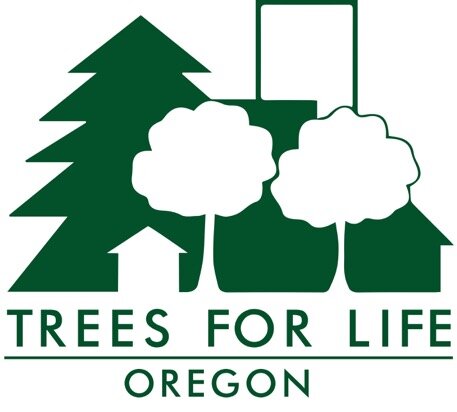Tree Matters by Bruce Nelson
This column also appears in the Trees For Life Oregon newsletter.
Bruce Nelson pruning a lacebark pine tree that was planted at Rigler Elementary in 2007
An opportunity to get many more big-canopy trees in the ground is underused. Let’s rally the City of Portland and nonprofits to do something about it.
Where can we currently find a thousand large-form trees growing in generally publicly accessible open spaces where they have room to reach their full size and where there’s so much more potential to plant more big trees?
I’m not referring to Portland’s public parks or golf courses but to public school grounds. Why not consider these school-sited trees an extension of our public parks system and organize volunteers in a systematic way to maintain them over time?
Think of all the land mass on which these schools rest and the huge environmental and social benefits to nearby residents these trees provide.
Through its Learning Landscapes Program, Portland Parks & Recreation’s Urban Forestry division has planted and mapped more than a thousand trees on 26 school grounds in the past two decades, though its website has not been recently updated. The program focuses on planting climate-forward, relatively low-maintenance trees. Its most commonly planted species have been Oregon white oak, ginkgo, Ponderosa pine, Douglas-fir, incense-cedar, red oak, giant sequoia, Kentucky coffeetree, American hornbeam, and black tupelo. The present inventory includes 88 different tree genera and 171 species, with 39 different conifer species, 31 different oak species, and 16 different broadleaf evergreen tree species.
Very few of these trees were planted with school district funds and all got in the ground with the invaluable cooperation of school districts, individual school personnel, and parent or community volunteers. Some of the trees were planted in the past by Friends of Trees or the Bureau of Environmental Services’ now defunct tree planting program (Urban Forestry has taken over BES’s tree planting role).
For 20 years I’ve been involved in one of these school sites, Rigler School Arboretum. This experience has greatly influenced my perspective on trees on school grounds. Like with so many newly planted trees, the biggest challenge is taking care of them once the more sexy planting activity has been done. The assumption is that once you plant a tree it will take care of itself. But the urban environment tests trees in ways they rarely encounter in their native habitat. Cared-for trees in the urban environment can often only live long and healthy lives with appropriate maintenance over their lifetimes, especially in their early years.
The first five to ten years of a tree’s life are crucial. Urban Forestry provides routine maintenance work on school-planted trees for a few years. Care involves watering, suppressing weeds, mulching to build healthy soil, protecting from external damage, and timely structural pruning. After ten years it’s vital to continue attending to water needs, storm damage, and protection from mower damage. This maintenance doesn’t happen in any systematic, regularly funded way in Portland school districts. At some locations, like Meek Elementary and Rigler, community volunteers do this on an ongoing basis. But the thousand-plus trees on school grounds need more help from the community in order to provide essential health and environmental services to Portlanders into the future.
How can this happen when no institutional entities want to take responsibility? To date, neither Friends of Trees nor Urban Forestry has shown ability or interest in expanding their services to school sites in this way.
Nonprofits could take this on, as Wisdom of the Elders and Verde have sometimes done under contracts with Friends of Trees or Urban Forestry. Nonprofits with the capacity and access to Portland Clean Energy Fund grants or to Urban Forestry assistance could deliver maintenance to trees at Portland-area schools. This opportunity could provide workforce training for targeted youth in the field of arboriculture while also offering meaningful employment for the BIPOC community.
Services delivered could include mulching every two years, structural training at three-year intervals until the trees are fifteen years old, summer watering for newly planted trees for several years after initial planting maintenance services end, conducting seasonal tree inspections to evaluate tree health, and updating Urban Forestry’s Learning Landscape Program online tree maps every three years.
Protecting and caring for trees on our school grounds and treating them as part of our greater commons make particular sense in light of the climate challenge we face. Doing this is also a way to model for school children and residents what taking climate action looks like.
I don’t have a sure solution, but I urge you to raise this issue with your City Council district representatives.

